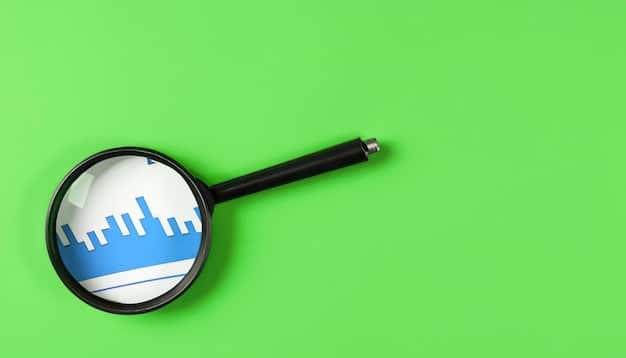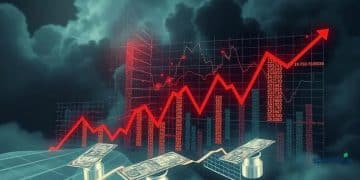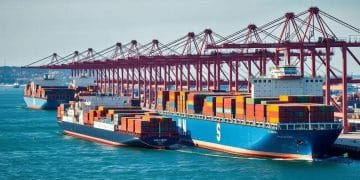Navigating Fed’s 0.75% Interest Rate Hike: A Business Owner’s Guide

The Federal Reserve’s recent 0.75% interest rate hike significantly impacts business owners by increasing borrowing costs, influencing consumer spending, and altering investment strategies, demanding adaptive financial planning and strategic adjustments to maintain economic resilience.
Understanding the implications of the Federal Reserve’s latest 0.75% interest rate hike is crucial for every business owner. This decision, aimed at curbing inflation, sends ripples through the economy, potentially affecting everything from operational costs to consumer demand. For businesses large and small, a clear grasp of these shifts is not just beneficial, but essential for strategic financial planning and sustained growth in a dynamic economic landscape.
Understanding the Federal Reserve’s Role
The Federal Reserve, often referred to as the Fed, serves as the central bank of the United States, established by the Federal Reserve Act in 1913. Its primary mandate involves promoting maximum employment, stable prices (controlling inflation), and moderate long-term interest rates. The Fed achieves these goals primarily through its monetary policy tools, which include setting the federal funds rate, conducting open market operations, and managing the discount rate. These tools collectively influence the availability and cost of money and credit in the economy.
A key component of the Fed’s power lies in its independence from political influence, allowing it to make decisions based purely on economic data and foresight. This independence is safeguarded through a decentralized structure, comprising a Board of Governors in Washington D.C., twelve regional Federal Reserve Banks, and the Federal Open Market Committee (FOMC). The FOMC is particularly relevant as it is responsible for setting the federal funds rate, which banks use to lend to each other overnight, thereby influencing other interest rates throughout the economy.
The Mandate and its Tools
The Fed’s dual mandate of maximum employment and price stability often presents a balancing act. For instance, aggressive rate hikes aimed at taming inflation can sometimes slow economic growth and potentially impact employment levels. Conversely, keeping rates too low for too long can fuel inflationary pressures. This delicate balance requires constant monitoring of economic indicators such as Gross Domestic Product (GDP), inflation rates (like the Consumer Price Index, CPI), and employment data.
The decision to implement a 0.75% interest rate hike is a significant move, signaling the Fed’s strong commitment to reducing inflation. Such a substantial increase indicates that inflationary pressures are perceived as persistent and broad-based, necessitating more aggressive action. For businesses, this move translates directly into higher borrowing costs, impacting everything from short-term loans to long-term investment financing.
The implications of such a significant rate adjustment extend beyond immediate borrowing costs. They signal a broader shift in the economic environment, one where the cost of capital is rising, and liquidity might become tighter. This requires businesses to reassess their financial models, scrutinize their debt structures, and anticipate potential shifts in consumer behavior driven by these monetary policy changes. The Fed’s actions are not isolated events but part of a continuous strategy to guide the economy toward long-term stability.
Immediate Impacts on Business Operations
The recent 0.75% interest rate hike directly influences various aspects of business operations, primarily by increasing the cost of capital. For companies relying on borrowed funds for daily operations, expansion, or inventory management, this hike means higher interest payments, directly affecting profitability. Lines of credit, commercial loans, and even credit card rates for business expenses will likely see an upward adjustment, eroding profit margins for businesses that carry significant debt.
Increased Borrowing Costs
The most immediate and tangible impact is on the cost of borrowing. Businesses often rely on loans for various purposes, whether it’s for working capital, purchasing new equipment, or funding large-scale projects. When interest rates rise, the cost of servicing this debt increases. This can divert funds that would otherwise be used for reinvestment, hiring, or innovation.
- Commercial Loans and Lines of Credit: Existing variable-rate loans will see an immediate increase in interest payments. New loans will be more expensive to acquire.
- Supply Chain Financing: Businesses that use financing to manage their supply chain will face higher costs, potentially increasing the price of goods.
- Capital Expenditure Planning: Projects requiring significant capital investment will need re-evaluation as the cost of financing them escalates.
Small and medium-sized enterprises (SMEs) are often more vulnerable to these increases as they typically have less access to diverse funding sources and may have less flexibility in absorbing higher costs. Larger corporations, while also affected, might have more sophisticated hedging strategies or access to capital markets for alternative financing.
Furthermore, the increased cost of borrowing can stifle investment. Businesses might postpone or cancel expansion plans, reduce R&D spending, or delay hiring new employees. This cautious approach, while fiscally responsible in the face of rising costs, can lead to slower growth for individual businesses and, cumulatively, for the broader economy. It’s a delicate balance between managing immediate financial pressures and maintaining a long-term growth trajectory.

Navigating Consumer Spending Shifts
An interest rate hike by the Federal Reserve doesn’t just impact businesses directly; it profoundly influences consumer behavior and spending patterns. As borrowing costs increase for consumers—affecting everything from mortgage rates to car loans and credit card interest—disposable income tends to decrease, leading to a more conservative approach to spending. This shift in consumer confidence and purchasing power demands a strategic response from businesses.
Impact on Consumer Loans and Mortgages
The ripple effect of higher rates starts with big-ticket items. Mortgage rates, directly tied to the broader interest rate environment, rise significantly, making homeownership less affordable. This can cool off the housing market, impacting industries ranging from construction to real estate and related services. Similarly, car loans become more expensive, potentially dampening vehicle sales.
Higher credit card interest rates also play a role. As consumers face larger minimum payments on their revolving debt, less money is available for discretionary spending. This impacts sectors reliant on consumer discretionary spending, such as retail, hospitality, and entertainment. Businesses in these areas must anticipate a potential slowdown in demand and adjust their strategies accordingly.
Adjusting Business Strategies
For business owners, understanding these shifts is critical. It involves anticipating which product categories or services might see reduced demand and how to pivot. This could mean:
- Tightening Inventory Management: Avoiding overstocking is crucial to prevent tying up capital in goods that might sell slower.
- Focusing on Value Propositions: Consumers become more price-sensitive. Businesses need to emphasize the value, durability, or essential nature of their products/services.
- Exploring Subscription Models: For certain services, subscription models can offer more predictable revenue streams even if individual transaction volumes decrease.
- Optimizing Marketing Spend: Directing marketing efforts towards retention and high-ROI channels becomes more important than broad, awareness-based campaigns.
The challenge lies in adapting quickly. Businesses that can offer flexible payment options, emphasize affordability, or innovate to meet changing consumer needs are better positioned to weather the storm. It’s an environment where efficiency, cost control, and a deep understanding of the customer become paramount. The goal is to retain customer loyalty and attract new customers by demonstrating acute awareness of their financial constraints.
Strategies for Financial Resilience
Building financial resilience is paramount for businesses in an era of rising interest rates. This is not merely about reacting to the immediate hike, but about creating robust financial frameworks that can withstand economic fluctuations. Proactive planning and a keen eye on financial metrics are key to navigating these challenging times successfully.
Rethink Debt and Capital Structure
With higher borrowing costs, businesses should meticulously review their existing debt and consider restructuring. This might involve:
- Refinancing Variable-Rate Debt: If possible, converting variable-rate loans to fixed-rate loans before rates climb further can provide predictability.
- Reducing Debt Burden: Prioritizing debt repayment, especially high-interest debt, can free up cash flow and reduce vulnerability to rate changes.
- Exploring Equity Financing: For growth-oriented companies, equity financing might become a more attractive alternative to debt, although it means diluting ownership.
A strong balance sheet, characterized by manageable debt levels and healthy cash reserves, stands as a buffer against economic shocks. Businesses should also scrutinize their capital expenditure plans. Projects with lower returns on investment might need to be deferred or re-evaluated, focusing instead on initiatives that offer rapid returns or critical operational efficiencies.
Optimize Cash Flow and Operations
Efficient cash flow management becomes even more critical when interest rates rise. Every dollar tied up in inefficient processes or excessive inventory represents a missed opportunity or an unneeded cost.
This involves optimizing accounts receivable and payable cycles to ensure cash comes in faster and goes out slower. Negotiating better terms with suppliers, implementing just-in-time inventory systems, and improving production efficiency can all contribute to healthier cash flow. Furthermore, a thorough review of operational expenses is essential to identify areas for cost reduction without compromising quality or core business functions. This could include technology adoption to automate processes, energy efficiency improvements, or renegotiating vendor contracts.
Ultimately, financial resilience stems from a holistic approach that integrates cautious borrowing, strategic investment, and rigorous operational efficiency. It’s about being nimble enough to adapt to changing market conditions while maintaining a clear vision for long-term sustainability. Businesses that master these strategies will be better positioned not just to survive, but to thrive amidst economic uncertainties.

Investment and Expansion Considerations
For business owners, the Federal Reserve’s interest rate hike significantly alters the landscape for investment and expansion. Higher borrowing costs mean that the hurdle rate for new projects increases, necessitating a more rigorous evaluation of potential returns. This environment calls for a recalibration of growth strategies, focusing on projects with robust profitability and clear strategic alignment.
Re-evaluating Return on Investment (ROI)
Any planned expansion, whether it’s opening a new location, acquiring new machinery, or developing a new product line, needs to be re-evaluated under the new interest rate regime. Projects that might have seemed viable with lower financing costs could now appear less attractive.
- Higher Cost of Capital: The increased cost of borrowing directly impacts the discount rate used in valuing future cash flows, reducing the Net Present Value (NPV) of potential investments.
- Long-Term Debt Considerations: Businesses planning large-scale, long-term investments based on debt financing will face higher overall costs, impacting the project’s profitability over its lifecycle.
- Focus on Efficiency and Automation: Investments that lead to significant cost savings, process efficiencies, or reduced labor costs might become more attractive due to their immediate impact on the bottom line.
This is a time for prudence, not paralysis. Instead of broad expansion, businesses might consider targeted investments that directly address existing bottlenecks or offer significant competitive advantages. This could involve upgrading technology to reduce operational costs, investing in R&D to create unique products, or acquiring smaller, synergistic businesses that offer immediate value. The focus shifts from growth at any cost to growth that is sustainable and deeply rooted in financial prudence.
Strategic Growth vs. Defensive Measures
The interest rate environment often forces businesses to balance aggressive growth strategies with more defensive financial measures. While growth remains a long-term goal, the immediate priority might shift towards strengthening the financial core.
This includes building stronger cash reserves, optimizing supply chains to reduce inventory holding costs, and enhancing risk management frameworks. Businesses might also explore partnerships or collaborations that allow for shared investment risk and expanded market reach without incurring substantial new debt. The key is to maintain a strategic outlook, ensuring that any investment or expansion aligns with the company’s long-term vision while being financially justifiable in the current economic climate.
Ultimately, the challenge lies in finding opportunities for smart growth amidst rising costs. This requires a deep understanding of market trends, a clear assessment of internal capabilities, and a commitment to disciplined financial decision-making.
Communication and Stakeholder Management
In times of economic uncertainty, clear and consistent communication with all stakeholders becomes critical for business owners. The Federal Reserve’s interest rate hike can create anxieties among employees, investors, suppliers, and customers. Proactive and transparent communication can build trust, manage expectations, and solidify relationships, fostering resilience and collective confidence.
Engaging Employees and Teams
Employees are often the first to feel the impact of economic shifts, as concerns about job security, wages, and company stability can arise. Business owners should:
- Be Transparent: Share an honest assessment of the economic climate and its potential impact on the business, without inciting panic.
- Address Concerns: Provide avenues for questions and concerns, offering reassurance where possible and outlining steps the company is taking to adapt.
- Emphasize Unity: Reinforce the idea that navigating challenges is a collective effort, emphasizing teamwork and shared goals.
Clear communication can help maintain morale, productivity, and commitment. It also provides an opportunity to explain how individual roles contribute to the company’s financial health, empowering employees to be part of the solution rather than merely observers of the shifting landscape.
Managing Investor and Supplier Relations
Investors will be keen to understand how the business plans to maintain profitability and growth in a higher-interest-rate environment. Suppliers, on the other hand, might be concerned about payment terms and the stability of the business relationship.
For investors, regular updates on financial performance, cost-cutting measures, and strategic adjustments are essential. Highlighting liquidity, cash flow management, and reduced debt exposure can build confidence. For suppliers, maintaining strong relationships through open dialogue about payment schedules and potential volume changes can prevent disruptions to the supply chain. Proactive communication signifies stability and a commitment to strong partnerships, even when conditions tighten.
Effective stakeholder management during economic shifts is about more than just relaying information; it’s about fostering a sense of shared understanding and collaborative problem-solving. Businesses that prioritize this open dialogue are better equipped to navigate challenges with the support and trust of their entire ecosystem.
Looking Ahead: Long-Term Horizon
While the immediate impact of the Federal Reserve’s 0.75% interest rate hike demands tactical adjustments, business owners must also maintain a strategic long-term perspective. The current economic climate might be challenging, but it also presents opportunities for innovation, efficiency gains, and ultimately, sustainable growth for those who adapt thoughtfully.
Anticipating Future Policy Shifts
The Fed’s actions are data-dependent, meaning future rate decisions will be influenced by inflation trends, employment figures, and global economic conditions. Businesses should stay informed about these macroeconomic indicators to anticipate potential further rate hikes or, in time, eventual rate cuts. This informed foresight allows for more agile financial planning and strategic positioning.
- Economic Monitoring: Regularly track key economic reports from government agencies and reputable financial institutions.
- Scenario Planning: Develop different financial scenarios (e.g., further rate hikes, recession, stabilization) to prepare for various outcomes.
- Flexibility in Operations: Build adaptability into supply chains, production processes, and staffing models to respond quickly to changing market demands.
A long-term view also involves understanding that economic cycles are natural. While the current cycle calls for caution, it also lays the groundwork for future stability. Businesses that invest in their core strengths, innovate their offerings, and build strong customer relationships during challenging periods often emerge stronger when the economic tide turns.
Building Sustainable Growth Strategies
Beyond managing immediate costs, the current environment is an opportune time to focus on sustainable growth. This includes:
Diversifying revenue streams to reduce reliance on any single market segment or product. This mitigates risk and opens new avenues for growth. Similarly, investing in digital transformation and automation can significantly improve operational efficiency and reduce long-term costs, making businesses more resilient to economic downturns. Cultivating a strong brand and fostering customer loyalty through exceptional service and value can also insulate businesses from price sensitivity.
The lessons learned during this period of economic adjustment will undoubtedly shape future business models. By focusing on efficiency, prudence, and strategic innovation, business owners can not only navigate the current challenges but also position their enterprises for robust and sustainable success in the years to come.
| Key Impact | Brief Description |
|---|---|
| 💸 Cost of Borrowing | Higher interest on commercial loans and credit lines directly impacts operational costs. |
| 🛍️ Consumer Spending | Consumers face higher debt costs, leading to reduced discretionary spending and demand. |
| ⚖️ Investment Decisions | Expansion projects require re-evaluation as projected returns diminish with higher capital costs. |
| 🛡️ Financial Resilience | Emphasizes optimizing cash flow, managing debt, and efficient operations for stability. |
Frequently Asked Questions About Rate Hikes
A 0.75% hike means your variable-rate loans and lines of credit will become more expensive, increasing your operational costs. It also signals that obtaining new financing will be pricier, directly impacting your ability to invest in new projects or expand without incurring greater debt servicing expenses.
Higher interest rates on consumer loans, credit cards, and mortgages reduce disposable income for households. This typically leads to a slowdown in consumer spending, especially on non-essential goods and services. Businesses should anticipate a potential dip in demand and adjust inventory and marketing strategies accordingly.
Yes, strategies include optimizing cash flow through efficient accounts receivable, reducing non-essential expenses, and perhaps refinancing variable-rate debt to fixed rates if possible. Focusing on core profit centers and re-evaluating capital expenditures are also crucial steps for financial resilience.
It’s advisable to re-evaluate expansion plans. Higher borrowing costs mean that the projected return on investment for new projects needs to be higher to justify the expense. Consider if the expansion is essential for immediate survival or long-term sustainability, and explore less capital-intensive growth strategies if feasible.
Transparency is key. Clearly communicate the potential impacts of the rate hike on the business and the proactive steps being taken to adapt. Foster an open dialogue, address concerns, and emphasize teamwork to maintain morale and confidence among employees, investors, and suppliers.
Conclusion
The Federal Reserve’s 0.75% interest rate hike signifies a pivotal moment for business owners, demanding a thorough reassessment of financial strategies and operational efficiencies. While presenting immediate challenges in terms of increased borrowing costs and dampened consumer spending, it also serves as a catalyst for greater financial discipline and proactive planning. Businesses that embrace stringent cash flow management, prudent investment decisions, and clear communication with stakeholders will be better equipped to navigate this dynamic economic environment, emerging stronger and more resilient in the long term.





